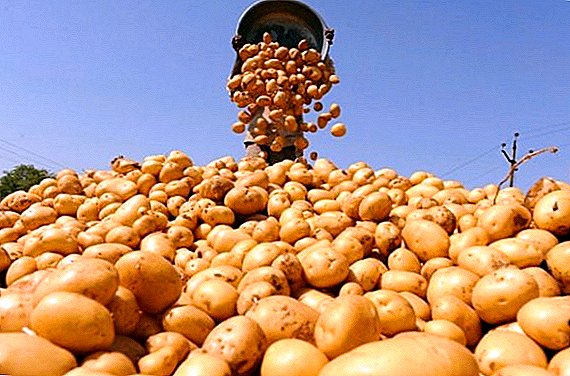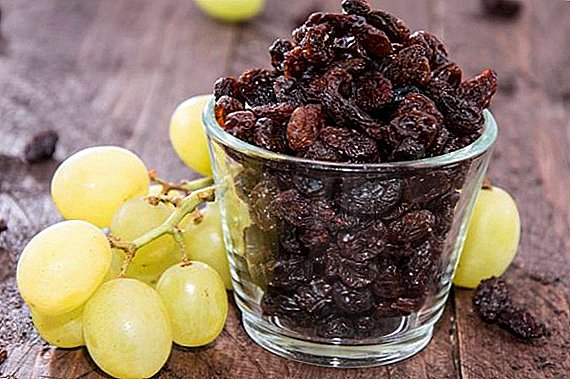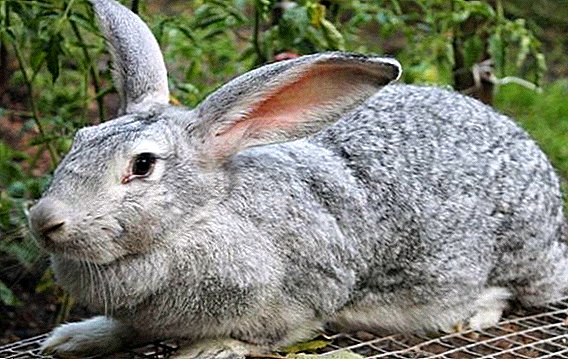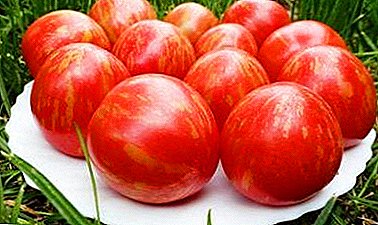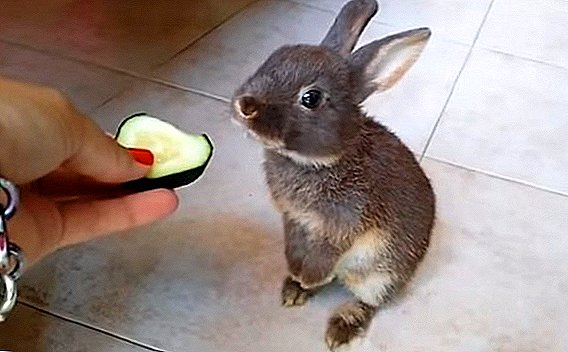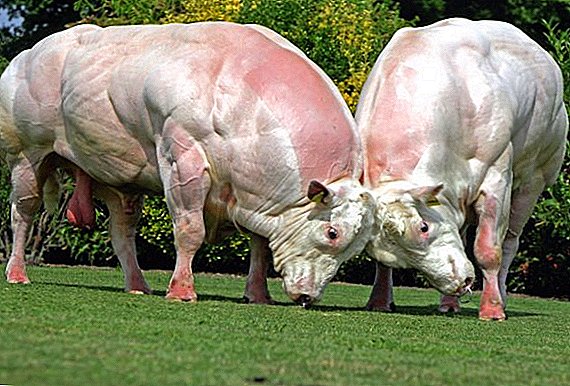 Today, you will learn about breeding cattle breeds that can boast of great weight and unsurpassed productive qualities. Consider the record-breaking bulls, as well as tell you about the largest wild, untidy animals.
Today, you will learn about breeding cattle breeds that can boast of great weight and unsurpassed productive qualities. Consider the record-breaking bulls, as well as tell you about the largest wild, untidy animals.
The largest breeds of cattle
Selection work, culling and selection of partners allowed us to obtain breeds that have unimaginable weight indicators.
Hereford
English meat breed, which was bred in the XVIII century by culling on the basis of available local representatives of cattle. Improving the quality of the breed in the future engaged in the breeders of the United States. In 1928, the Hereford cows were brought to the USSR, where they were used for crossing with dairy and meat breeds.
Both bulls and cows have a muscular massive body, and also differ in shortened limbs. At birth, young stock has a weight of 28-33 kg, but the mass of adult representatives of the breed is 30-40 times more. The maximum weight of a cow is 850 kg, and a bull - 1350 kg. It should be borne in mind that the average height is only 125 cm.
Important! Initially, the breed was used as a stinging force, on which the efforts of breeders were directed."Herefords" have a chest girth of about 2 m, a chest depth of 72 cm and a body length of about 1.5 m. Animals are valued for the marketable and taste qualities of marble meat, the slaughter yield of which reaches 70%.

Golshtinsky
Dutch breed of dairy, which is one of the most productive and common in the world. Americans were engaged in selection in the middle of the XIX century. At the same time, efforts were aimed at increasing the volume of milk and live weight of the horned.
The average weight of adult cows is 650-750 kg, and bulls - 0.9-1.2 tons. At the same time, selection work still does not stop, since the task is to bring the minimum weight to 850 kg.
Find out how to keep the bulls.The constitution of the body of animals is habitual, the height at the withers is 140 cm, the depth of the chest is up to 80 cm inclusive. They have a large volume udder, which has a cup shape.
Despite the fact that the weight of bulls rolls over a ton, the slaughter of meat does not exceed 55%, which indicates a heavy skeleton of animals. At the same time, the milk yield may exceed 10 thousand kg per year. 
Kyansk (Italian)
The Italian breed of meat direction, the selection of which was engaged in ancient Rome. Animals are aggressive and agile. Given the size, a cow can kill a person by hitting the rear or front hoofs. “Kyantsy” without any problems jump over fences, the height of which reaches two meters.
Check out the breeds of cows.The average mass of an adult cow is 750-1000 kg, and the bull - 1.2-1.5 tons. Such a large weight is due to the average height at withers 150-180 cm, because of which the animal seems huge. The main difference of this breed is rapid growth. Daily weight gain reaches 2 kg. At the same time at the age of 1 year, the average weight is 475 kg.
Slaughter meat yield - 60-65%, while products are dietary, as it has a low percentage of fat. 
Kalmyk
Russian meat breed, which was bred on the basis of local cattle that came from Western Mongolia. Cows are distinguished by a well-developed maternal instinct, because of which even the owner cannot approach the young.
The weight of cows is 450-600 kg, bulls - 750-900 kg. The constitution of the body is similar to the oxen of oxen. It should be noted that Kalmyk cows are well adapted to the sharply continental climate. They can accumulate a lot of fat to survive the cold winters.
Did you know? Kalmyk cows in search of food can travel up to 50 km per day even in extreme cold due to thick wool and fatty deposits.Slaughter yield - 60%. At the same time 70% of the total mass falls on the muscles and only 10% - on the fat. Annual milk yield is small: no more than 1500 kg. Milk has a fat content of 4.2-4.4%.

Charolais
The French breed of meat direction, which was bred in the XVIII century in the Charolais region, thanks to which it got its name. For Sharolez cows, severe calving is characteristic, due to which it is necessary to do a cesarean section.
These are truly huge muscular animals, looking at which it seems that their body constitution is unnatural. The weight of the cow is 650-1100 kg, and the bull - 950-1400 kg. It should be borne in mind that the maximum height at the withers is 145 cm, and the slanting length of the body does not exceed 170 cm. Young animals are rapidly gaining weight and already at the age of 6 months have a weight of 230 kg.
Important! Cows can be used for milk production up to 15 years.Breed is valued for high quality dietary meat, the output of which is up to 80%. As for milkiness, in this regard, Sharolese cows are losing heavily. For the year, each individual can produce no more than 2.5 thousand kg, and the fat content of the product is 4%.

Shorthorn
English breed, which refers to both the meat and the meat and milk direction. It was bred in the XVIII century by crossing the local cattle with such breeds as the Dutch and Galloway. It is interesting that initially the selection went in the meat direction, but already in the XIX century, individuals were selected with a large mass and good milk yield.
Since the selection work was aimed at obtaining high-quality meat and milk at the same time, the mass of adult animals does not break records. Cows on average weigh 550-750 kg, bulls - 800-1100 kg. In rare cases, there are individuals that weigh up to 1300 kg inclusive. Representatives of the Shorthorn breed have a small height at the withers - up to 130 cm. The slanting body length is 155 cm. The chest girth is 185-200 cm.
Get acquainted with the breeds of cows meat and dairy.Breed is valued for the slaughter output of marble meat, which reaches 81%. The milk content of cows varies between 2.5 and 6 thousand kg per year. The products are of high quality, which is why the breed is bred not only in Europe, but also in the USA, Canada, Australia and in some regions of the Russian Federation.

The largest and heaviest bulls in the world
In the Guinness Book of Records listed representatives of the rocks that hit their weight, height or build. Then you will learn about the most massive bulls on the planet.
Learn interesting facts about cows.
Donetto (Kian breed)
The record holder was identified at an exhibition in 1955 in Arezzo (Italy), it turned out to be a representative of the Kian breed, a bull named Donetto. Its weight was 1740 kg. Moreover, the average weight of bulls often does not exceed 1500 kg. 
Field Marshal (Charolais breed)
An eight-year-old bull named Field Marshal became the heaviest bull in England. His weight is 1670 kg, and at the age of seven he weighed 136 kg less. The animal was not raised for exhibitions, but was used on the farm for insemination and various works. 
Did you know? The heaviest cow in the world nicknamed Mount Katadin lived at the beginning of the 20th century. Its weight reached 2270 kg, and its girth was 400 cm.
Daniel (Holstein breed)
Bull Daniel want to include in the Guinness Book of Records as the highest representative of cattle in the world. Its height at the withers is 194 cm. The animal consumes 4 times more feed than its fellows. The bull is more than 40 cm taller than its neighbors. Interestingly, the Holstein breed is usually not famous for its enormous growth. 
Repp (Podolsky breed)
The Ukrainian record holder, a seeding bull, representing the Podolsk breed, has a mass of 1.5 tons and is truly an awesome appearance. It is the largest and heaviest bull in the CIS. In the year due to his sperm more than 50 thousand units of young animals are born. 
The biggest wild bulls
In the wild, a considerable number of species of cattle dwell, which can boast of great weight and body length. About them further it will be a question.
Find out what species of wild bulls are preserved for today.
Gaur (Asian bison)
Belongs to the genus of real bulls. Distributed in some areas of India, Pakistan, Thailand and Cambodia. The cultivated form is called "gayal."
Under natural conditions, animals grow gigantic. Their average weight is 1.5 tons, and in some cases it reaches 2 tons. The height at the shoulders is 230 cm, and the length of the horns reaches 90 cm. At the moment, the population of gaurs is estimated at 20 thousand individuals. In many regions, the species is endangered. 
Bison (European bison)
European bison belongs to the genus of buffaloes. Earlier this animal was found throughout Russia and Europe, but already in the Middle Ages, the bison's habitat decreased. They remained only in Central and Eastern Europe. Now only isolated representatives remained in the wild nature, however many European countries breed animals in zoos in order to release them into the wild, to the reserve.
Did you know? Bison do not get along well with other large herbivores, which is why in the reserves where they are bred, the bodies of feeding often find the bodies of elks, deer and horses. In this case, the animal is afraid of people and attacks only in case of danger.Bison is the heaviest land mammal in Europe. At the beginning of the 20th century there were individuals whose mass reached 1.2 tons. In conditions of bondage, animals grow less weighty, up to 900 kg. The length of the torso of males reaches 300 cm, the height at the withers is 190 cm, and the circumference of the chest is more than 2.5 m. The females are distinguished not only by their smaller size, but also by the fat content of milk that they feed their calves. It is 3 times fatter than cow.
At the beginning of our century, the bison population numbered about 3.5 thousand individuals. 
American bison
A close relative of the bison, which belongs to the genus of bison. Since they can interbreed with each other, they are often referred to as one species.
Earlier, the American bison was distributed throughout North America, but at the moment its habitat has decreased. Bison is found only north and west of Missouri. In the USA, Canada and Mexico, the animal is considered both wild and domestic.
Find out what is interesting about the bull watusi.The body length of the bison is 250-300 cm, the average weight is 900-1300 kg. Height at withers reaches 200 cm. At the same time, representatives of the genus can reach speeds above 50 km / h (faster than a horse).
The population of American bison, which are contained for commercial use, is about half a million heads. In the wild, there are no more than 20 thousand individuals. 
Representatives of breeding breeds of cattle in terms of mass are already superior to their wild counterparts. Cows and bulls can boast not only impressive size, but also the quality of meat, as well as the volume of milk produced. At the same time, the work does not stop, which will allow in the near future to breed fast-growing undemanding animals with a huge body weight and a large percentage of output.



